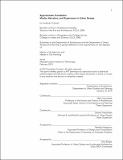Approximate translation : media, narrative, and experience in urban design
Author(s)
Crisman, Jonathan
DownloadFull printable version (13.12Mb)
Alternative title
Media, narrative, and experience in urban design
Other Contributors
Massachusetts Institute of Technology. Department of Architecture.
Advisor
Mark Jarzombek and Dennis Frenchman.
Terms of use
Metadata
Show full item recordAbstract
Approximate translation is developed as a design process through which the place-embedded history of an urban environment can be understood, allowing for better design and intervention in that urban environment. Generally, approximate translation champions media, narrative, and experience as design elements that have traditionally been excluded from disciplinary discourse and are necessary for any design in contemporary practice. The processes of displacement, replacement, and surrealization are proposed as three such translations and are demonstrated in the transformation of the Boston neighborhood of Allston into Allstonland (a theme park in Hong Kong), New Allston (a revised Allston with six interventions organized around Platonic Forms), and a live model of New Allston. The live model is developed as a new form of architectural and urban design representation that can incorporate the temporal, mediatic, and experiential elements which are ill-conveyed through conventional means. Ultimately, approximate translation is intended to transform urban environments into their ideal forms, to inject new meaning into empty urban signifiers, to alter local subjectivities, and to generate a new sense of civitas. Theories of media, theming and scripted space, Pop and Surrealist art, Marxism and neoliberal capital, postmodernism, aesthetics, semiotics, modernist architecture, epistemology, and hermeneutics are drawn upon in order to construct a framework for this that is both robust enough for use in practice and pedagogy, as well as mutable enough for further refinement and expansion.
Description
Thesis (M.C.P.)--Massachusetts Institute of Technology, Dept. of Urban Studies and Planning; and, (M. Arch.)--Massachusetts Institute of Technology, Dept. of Architecture, 2013. This electronic version was submitted by the student author. The certified thesis is available in the Institute Archives and Special Collections. Cataloged from student-submitted PDF version of thesis. Vita. Includes bibliographical references (p. 153-155).
Date issued
2013Department
Massachusetts Institute of Technology. Department of Architecture; Massachusetts Institute of Technology. Department of Urban Studies and PlanningPublisher
Massachusetts Institute of Technology
Keywords
Urban Studies and Planning., Architecture.